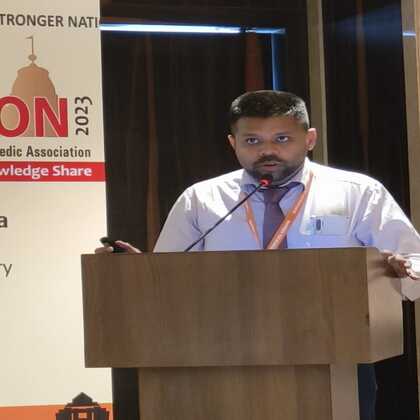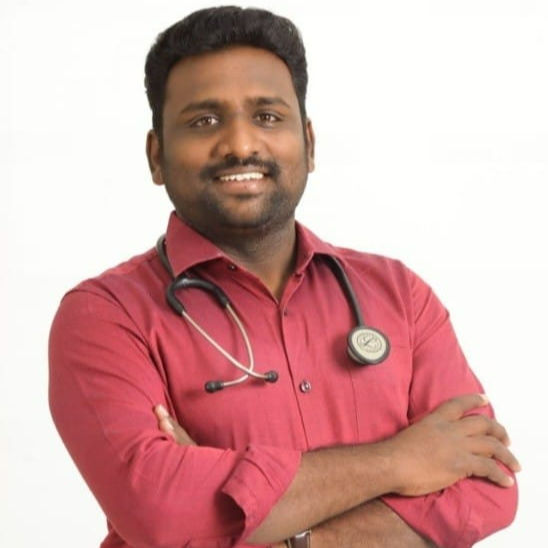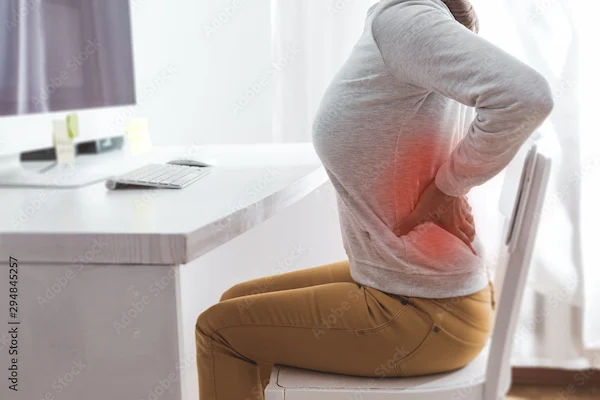How To Reduce Tailbone Pain?
Discover effective ways to reduce tailbone pain with simple home remedies, posture adjustments, and medical treatments. Find relief and improve comfort today!

Written by
Last updated on 3rd Jul, 2025
The tailbone or coccyx is a small bone at the bottom of the spine that helps body weight while sitting. Usually, it does not cause any problems; however, injuries from falls, childbirth, or excess weight can lead to pain. Though often ignored, tailbone pain can affect daily life and may need medical attention. Understanding its role and common issues can help in managing the discomfort better.
Identifying Symptoms of Tailbone Pain
People can experience various types of pain in the tailbone. These include:
Sharp (piercing) or dull (achy) pain on the tailbone.
Tailbone pain during stool
A pain when standing up from a sitting position
Pain during intercourse
Other common symptoms associated with tailbone are:
Back pain
Depression
Anxiety
Sleeping disorder
Sciatica
Diagnosing Tailbone Pain
The healthcare provider will first review the patient's medical history for an in-depth diagnosis. Then, they will ask if there was any previous injury or trauma in the tailbone area, such as difficulty in childbirth or falls. Then, they will examine the area to detect fractures, lumps, or infections (abscesses).
Depending upon the medical history and symptoms, the doctor will prescribe imaging and laboratory tests to determine the source of pain.
X-rays or MRI (magnetic resonance imaging) scans of the tailbone or spinal cord
A rectal exam to check if the rectal muscles are causing any pain
A pelvic exam to determine the pelvic floor strength
Blood tests to assess if there is any infection or autoimmune condition
Non-Surgical Treatments
Most people get cured through specific home remedies and non-surgical treatments. These include:
Taking non-steroidal anti-inflammatory drugs (NSAIDs) for reducing pain and swelling.
Taking coccygeal nerve block, an injection made with steroids and numbing medications for easing pain and inflammation.
Sitting on a wedge-shaped gel cushion or doughnut pillow to reduce the pressure from the tailbone area.
Using a stool softener can alleviate tailbone pain during faeces.
Apply 20-30 minutes of hot or cold packs to the lower back.
Also, a hot bath can ease the pain and relax the muscles.
Physical therapy will help to improve posture and stretch the muscles. The therapist may recommend strengthening the tailbone
muscles by supporting the pelvic floor.
Sometimes, massage therapy becomes beneficial for getting temporary relief.
Alternative Therapies
Tight and inflamed muscles around the tailbone can lead to nerve compression and misalignment, causing discomfort and restricted movement. Chiropractors specialise in realigning the spine, including the tailbone, to reduce pain and promote healing. Many patients also experience improved range of motion after chiropractic treatment.
Chiropractic Treatment for Tailbone Pain:
Spinal adjustment to correct misalignments
Treatment of pelvic tissues to relieve pressure
Soft tissue therapy for muscle relaxation
Hot and cold therapy for pain relief
Post-care advice for long-term maintenance
Acupuncture is another effective method for managing tailbone pain. By stimulating specific points in the body, acupuncture activates the central nervous system, releasing chemicals that aid in pain relief and healing. This therapy not only improves physical well-being but also enhances emotional balance.
Surgical Options
Surgery for tailbone pain involves the removal of the tailbone, which is known as a coccygectomy. Usually, the doctors don't recommend this surgery. However, it can only be done by experienced spinal or orthopaedic surgeons. The doctors only refer for this surgery if:
The painkillers, steroid injections, physiotherapy, and other strategies fail.
Also, there is stubborn pain due to congenital disabilities, tumours, degenerative, or psychosomatic.
There are two types of coccygectomy: total coccygectomy and partial coccygectomy. The surgeon will directly cut the tailbone and remove it. In partial coccygectomy, the surgeon removes some parts of the tailbone.
Lifestyle Modifications
People must implement proper lifestyle modifications to avoid tailbone pain. First, they must eat a fibre-rich diet that can prevent constipation and soften the stool. These include fruits, vegetables, oats, almonds, quinoa, and more. If these don't work, they should take a fibre supplement. Also, drink plenty of fluids.
A 2017 study has found that people with tailbone pain experience improvement by performing exercises that increase thoracic spine mobility. Also, these stretch the iliopsoas and piriformis muscles of the hips and buttocks. Ultimately, these will improve tailbone pain. Here are some of these exercises:
Single neck knee hug: Individuals should lie down with their back and hold one knee to the chest. They should extend the feet straight, pull the knee to the chest, hold for 30 seconds, and then switch sides.
Figure 4 stretch: People should lie down with their backs and raise their knees towards the ceiling. Keep the feet flat. They should bend the right leg toward the body, rest the right ankle on the left knee, and pull the left thigh toward the chest. The same should be done on the other side.
To Know More Consult Top Orthopaedicians
Child pose: At first, individuals must kneel with their knees and sit on their heels. They should place both hands on the floor, move the body forward, slide the arms, and lower the head. Then, extend the arms forward, aiming to touch the forehead to the floor, holding for 20-30 seconds.
Prevention Strategies
Here are some tips to maintain good postures that help to avoid tailbone pain.
Sitting in the same place for a long time, specifically on a hard surface, should be avoided.
Good posture should be maintained by sitting straight, keeping the back against the chair, and relaxing the shoulders.
Using stair railings, keeping pathways clear, and avoiding your phone while walking to reduce the risk of falling
Leaning forward while sitting can help reduce pressure on the tailbone.
One should be cautious during activities like cycling, as they can lead to tailbone pain.
Prognosis and Recovery
Generally, tailbone pain goes away within a few weeks. In severe cases, it will take more time to heal. However, the recovery process depends upon the severity of the symptoms, the causes of the pain, and the patient's healing ability. Also, it depends upon how well the patient follows the doctor's treatment procedures and recommendations. Only a few people experience chronic discomfort despite proper treatment.
Conclusion
Treating tailbone pain is not an impossible task. To avoid this pain, people must modify their postures while sitting. Most people get cured through home remedies. Only a few cases require proper medical attention and treatment. Thus, they should be alert and visit the doctor if the tailbone pain disappears after several weeks.
Consult Top Orthopaedicians
To Know More Consult Top Orthopaedicians
Dr. Anil Sharma
Orthopaedician
42 Years • MBBS, MS Orthopedics
New Delhi
AAKASH MEDSQUARE, New Delhi

Dr. Anil Pradeep Jadhav
Orthopaedician
23 Years • MBBS MS (Ortho)
Nashik
Apollo Hospitals Nashik, Nashik
(25+ Patients)

Dr. Manoj Dinkar
Orthopaedician
15 Years • MBBS, Dip (Orthopaedics)
New Delhi
THE DOCTORS NESST, New Delhi

Dr. Mriganka Ghosh
Orthopaedician
11 Years • MD (Physician), DNB (Orthopaedics)
Howrah
Dr Mriganka Mouli Ghosh, Howrah

Dr. Pradeep Lucas
Orthopaedician
7 Years • MBBS, Diploma in Orthopaedics, Fellowship in DFSI
Bengaluru
Revival Multispeciality Clinic, Bengaluru
Consult Top Orthopaedicians
Dr. Anil Sharma
Orthopaedician
42 Years • MBBS, MS Orthopedics
New Delhi
AAKASH MEDSQUARE, New Delhi

Dr. Anil Pradeep Jadhav
Orthopaedician
23 Years • MBBS MS (Ortho)
Nashik
Apollo Hospitals Nashik, Nashik
(25+ Patients)

Dr. Manoj Dinkar
Orthopaedician
15 Years • MBBS, Dip (Orthopaedics)
New Delhi
THE DOCTORS NESST, New Delhi

Dr. Mriganka Ghosh
Orthopaedician
11 Years • MD (Physician), DNB (Orthopaedics)
Howrah
Dr Mriganka Mouli Ghosh, Howrah

Dr. Pradeep Lucas
Orthopaedician
7 Years • MBBS, Diploma in Orthopaedics, Fellowship in DFSI
Bengaluru
Revival Multispeciality Clinic, Bengaluru

